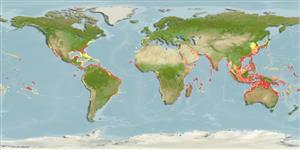Teleostei (teleosts) >
Tetraodontiformes (Puffers and filefishes) >
Monacanthidae (Filefishes)
Etymology: Aluterus: Name from Greek meaning not free or detached, referring to the pelvis that does not form a spiny project (as it does in triggerfish) (R. Chandler, pers. Comm. 10/2014)..
Environment: milieu / climate zone / depth range / distribution range
Ecology
Marine; reef-associated; depth range 3 - 120 m (Ref. 36484), usually 3 - 20 m (Ref. 40849). Subtropical; 46°N - 30°S, 180°W - 180°E
Circumtropical.
Size / Weight / Age
Maturity: Lm ? range ? - ? cm
Max length : 110 cm TL male/unsexed; (Ref. 9710); common length : 55.0 cm TL male/unsexed; (Ref. 5450); max. published weight: 2.5 kg (Ref. 26340)
Dorsal spines (total): 2; Dorsal soft rays (total): 43 - 50; Anal spines: 0; Anal soft rays: 46 - 52. Snout concave (Ref. 1602); olive brown to grey in color, juveniles may be yellowish brown with dark spots (Ref. 4421). Elongate, strongly compressed filefish; tan with blue lines and spots. Caudal fin rounded (Ref. 26938) and long (Ref. 13442). Gill opening oblique, pelvic terminus rudimentary or absent; body and head with scattered small black spots (Ref. 13442).
Inhabit lagoon and seaward reefs (Ref. 9710). Occasionally are seen under floating objects (Ref. 1602). Juveniles may travel with weed rafts in open ocean for a long time and reaching a large size. Adults are usually seen along deep coastal slopes or outer reef drop-offs in about 20 meters depth (Ref. 48637). Benthopelagic (Ref. 58302). Feed on algae, seagrass, hydrozoans, gorgonians, colonial anemones, and tunicates. Caught at the surface using a hand net (Ref. 26165).
Life cycle and mating behavior
Maturities | Reproduction | Spawnings | Egg(s) | Fecundities | Larvae
Hutchins, J.B., 1986. Monacanthidae. p. 882-887. In M.M. Smith and P.C. Heemstra (eds.) Smiths' sea fishes. Springer-Verlag, Berlin. (Ref. 4421)
IUCN Red List Status (Ref. 130435)
Threat to humans
Reports of ciguatera poisoning (Ref. 4690)
Human uses
Fisheries: commercial; gamefish: yes; aquarium: commercial
Tools
Special reports
Download XML
Internet sources
Estimates based on models
Preferred temperature (Ref.
123201): 22.6 - 29, mean 27.4 °C (based on 1766 cells).
Phylogenetic diversity index (Ref.
82804): PD
50 = 0.5625 [Uniqueness, from 0.5 = low to 2.0 = high].
Bayesian length-weight: a=0.01995 (0.00943 - 0.04220), b=2.93 (2.75 - 3.11), in cm total length, based on LWR estimates for this (Sub)family-body shape (Ref.
93245).
Trophic level (Ref.
69278): 2.8 ±0.4 se; based on diet studies.
Resilience (Ref.
120179): Medium, minimum population doubling time 1.4 - 4.4 years (Assuming tm=3-4).
Fishing Vulnerability (Ref.
59153): High to very high vulnerability (66 of 100).
Nutrients (Ref.
124155): Calcium = 11 [4, 33] mg/100g; Iron = 0.455 [0.208, 1.128] mg/100g; Protein = 18.8 [16.5, 21.0] %; Omega3 = 0.127 [0.055, 0.272] g/100g; Selenium = 28.5 [9.5, 68.4] μg/100g; VitaminA = 18.5 [4.0, 84.0] μg/100g; Zinc = 0.626 [0.387, 1.062] mg/100g (wet weight);
